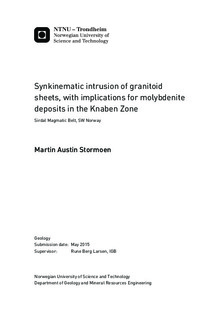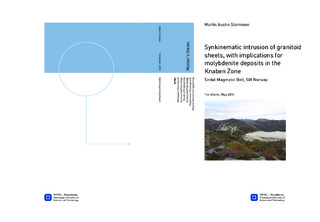| dc.description.abstract | The Knaben Zone represents a N-S-elongated zone with abundant xenolith screens and
molybdenite deposits within the late Mesoproterozoic Sirdal Magmatic Belt (SMB) batholith
in the Sveconorwegian orogen, in SW Norway. The SMB represents a significant component
of the western vicinity of the Sveconorwegian orogen, and has recently received attention due
to its lately defined sheer size and weak deformation. Through determining the significance of xenolith-rich zones the understanding of the evolution of the SMB can be greatly improved.
The main objective in this MSc thesis is to determine the lithological relationships and
magmatic and tectonic processes for the Knaben Zone. An evaluation of the evolution and
potential of the molybdenite deposits is also put forward, together with a regional comparison.
Detailed fieldwork and microscopic analysis of the Knaben Zone provide the basis for this
project, supported by whole-rock geochemistry and zircon geochronology.
Xenolith screens representing pre-Sveconorwegian bedrock (1252.8±8.7 Ma), and granitoid
sheets (1043.3±5.6 Ma) related to the SMB, dominate the geometry of the Knaben Zone, with
a pervasive moderate east-dipping parallelism. These are presented in a detailed geological
map of the area. The SMB granitoids are generally undeformed to weakly deformed, with
strain concentrated along xenolith screen contacts and local mylonite zones. Compressional
top-to-the-W kinematics are consistent at all scales along the deformation zones, and meltpresent deformation is widely documented. The deformation is largely expressed as ductile
duplex ramps, ramping up towards the west. Whole-rock geochemistry and crosscutting field
relations suggest a continuously evolving melt, from the least evolved K-feldspar porphyritic
biotite granite to highly evolved molybdenite bearing grey granite and leucocratic granites.
The whole-rock geochemistry displays a decoupling signature and distinct Nb, Pb, P and Ti
anomalies, a typical active margin signature. Disseminated molybdenite of magmatic origin
within the grey granite is the most economically viable molybdenite deposit, while smaller
deposits are largely confined to thrust-related, subhorizontal pegmatites.
Results from fieldwork, microscopic, geochemical and geochronological analysis are
synthesized to a synkinematic intrusion model for the granitoid sheets in the Knaben zone,
relative to the E-W-compression. The xenolith screens are essential for the molybdenite
deposits, geochemically by providing precipitating agents and structurally, by concentrating
fertile melts within the shear zones and anisotropies. The emplacement model, deduced from
key findings within the Knaben Zone, is likely to be scale-invariant, and provides a
structurally and petrological consistent emplacement model for the SMB at whole. Timing
and kinematics correlate with thrusting along major shear zones in the Sveconorwegian
orogen. The vast melt volume, and the geochemical signature related to the SMB, is best
explained by a tectonic setting in the vicinity of an active margin. | |

